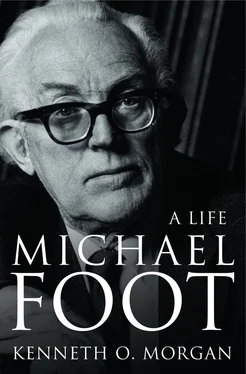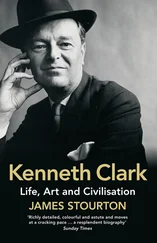In this quest, Stafford Cripps seemed at this period the natural messiah. Since the 1931 schism, with the defection of MacDonald and his Chancellor Philip Snowden to become allies of the Tories, Cripps had led a sharp advance to the left. He preached a style of socialism that went far beyond the cautious parliamentary parameters within which Labour had grown up. He joined the far-left Socialist League, a movement of middle-class intellectuals, formed in 1932, in large part from the ILP when it disaffiliated from the Labour Party. It was a movement in which Michael Foot was shortly to enlist. Cripps campaigned to promote a new foreign policy in alliance with the Soviet Union: the League of Nations was dismissed as ‘the International Burglars’ Union’. He also pressed for the social ownership of all major industries and utilities, based not on state nationalization but on workers’ control. At the 1933 party conference Cripps proclaimed in Marxist terms that a socialist government would never receive fair treatment under capitalism, with the City, the Civil Service and the establishment all ranged against it. He called for some form of emergency government to entrench socialism in our time. In January 1934 he caused even greater alarm and shock by suggesting that Buckingham Palace would be foremost amongst the institutions seeking to defeat an incoming Labour government. This doctrine horrified leaders such as Dalton, Attlee and Morrison: Beatrice Webb thought him an extremist and his ideas revolutionary. By the 1935 general election Cripps’s erratic behaviour meant that his star was soon to wane. He himself recognized the fact by giving private financial help to Clem Attlee as assistant party leader in Lansbury’s last phase. But to the young Michael Foot, a books-driven evangelist yearning for a cause, Cripps was the most obvious instrument of creating a new socialist society.
Foot’s conversion to socialism was, naturally, a huge shock to his traditionally Liberal family. Nothing like it had ever happened at Pencrebar. What made things worse was that they discovered his conversion to Labour indirectly, when the Daily Herald picked up a short comment in the Oxford undergraduate magazine Isis . But the shock was far from terminal: it was nowhere near as bad as a Foot becoming a Tory (the family’s response to Dingle’s effective electoral pact with the Tories in Dundee is not recorded). Isaac was shaken at first by his son’s transformation. However, he cheerfully told Michael that if he was to move from liberalism to socialism, he ought to absorb the thoughts of a real radical. An even more intense perusal was needed of the thoughts of William Hazlitt (who, among other things, was a republican who voiced public grief on hearing of Napoleon’s deeply regrettable defeat at Waterloo). 10 Even the Labour Party could be better understood by recourse to the bookshelves of Pencrebar. Michael’s mother Eva seems to have been more immediately upset by the news, and he had to write to her explaining his belief that only socialism, rather than any form of liberalism, had the answer to problems of poverty and peace. But in time his mother came to a more complete appreciation than Isaac ever did of the reasons for Michael’s becoming a socialist. Certainly her Labour son’s political advance was as important to her as that of any of her Liberal brood.
Michael Foot’s earliest activities as a left socialist in the streets of Liverpool had, of course, immediate social evils to condemn. But what is striking about his socialism, then and always, is how far this very English rebel, who travelled relatively little until his old age and was dedicated to worshipping the liberty tree of his country’s past, framed his socialism in an international context. This, of course, was common to many idealistic young people in the thirties, with the rise of totalitarian dictatorship and the threat of a global confrontation with the democratic peoples. Foot played his full part in campaigning against fascism, for the Popular Front in Spain, and in denouncing Chamberlainite appeasement. But he had perspectives of his own in relation to two important countries further afield – India and Palestine.
Since his undergraduate days, Foot had had a special affinity with India and the Indians. He liked their food, he admired their culture; perhaps, as Philip Snowden said of Keir Hardie, India ‘appealed to the seer and the mystic in him’. He had listened avidly to his father’s accounts of the views of Mahatma Gandhi during the Round Table conference which explored the future government of India in 1930–31. He had been active in the Anglo-Indian Lotus Club. In the Oxford Union he was friendly with progressive Indians like the sharp young Parsee D. F. Karaka, whose memoirs testified to Foot’s generosity of spirit and enthusiasm for multiculturalism. 11 Foot carried on this involvement right through the thirties. Long after Indian independence in 1947, devotion to India was a golden thread in his career. India embodied key political and cultural values that he cherished. A major influence from 1934 onwards was his contact with Krishna Menon, a member of St Pancras borough council until 1947. Menon’s energetic work as chairman of the St Pancras Education and Library Committee, especially on library and arts provision for children, was greatly admired. He first met Michael when he edited the book Young Oxford and War , to which Michael contributed, and Michael was to be much associated with him in campaigning for the Socialist League in London. Krishna Menon was an exciting guru: Foot’s visits to his legal office at 169 The Strand always remained memorable for him. He joined the strongly pro-Congress Commonwealth of India League (previously the Home Rule for India League), of which Krishna Menon had been General Secretary since 1930, and read Indian newspapers avidly. At this period Foot’s instinct was to call for gradualism in the demands of the Congress, and he wrote urging Indian nationalists to cooperate with the authorities as the new Indian constitution was being drafted at Westminster in 1934–35. Krishna Menon’s tendency to build links between Congress and the British Communist Party was something that disturbed Foot later in that decade.
But Indian self-government was a glowing ideal for him throughout the thirties, merged into the Labour Party’s campaigns for social justice and world peace. This was widely true of younger socialists in Britain, contrasting with a relative lack of interest in Africa. Several of Foot’s most admired fellow-socialists were zealous in the Commonwealth of India League. Thus he discussed the subcontinent on long walks with H. N. Brailsford, who had first-hand knowledge of India, was a personal friend of Gandhi and was to write Subject India for the Left Book Club during the war. 12 Harold Laski was another key socialist intellectual much concerned with Indian independence: he had after all served on the special jury in the O’Dwyer v. Nair libel case that followed the dismissal of General Dyer, the perpetrator of the massacre at Amritsar in 1919, and was shocked by the sheer racialism that it revealed, especially from the judge. Aneurin Bevan, shortly to be Foot’s closest political ally and mentor, always gave India a high priority, as did Bevan’s wife Jennie Lee, while amongst Foot’s literary heroes H. G. Wells was another ally on Indian matters: The New Machiavelli was an important text for opponents of the Raj. Amongst Indian leaders, in addition to Krishna Menon, Foot also met Pandit Nehru and heard him speak in 1938 at a meeting on Spain. Foot’s continuing links with the Nehru family – Nehru’s daughter Indira and her sons Sanjay and Rajiv Gandhi especially – remained important for the next half-century and more.
Foot was always amongst those who encouraged Indian nationalists when war broke out in 1939 to try to work with the British government, certainly not to join the radical nationalist movement associated with Subhas Chandra Bose, who sought aid from the invading Japanese to overthrow the Raj. On the other hand, the authoritarian policies of the Viceroy, the Marquess of Linlithgow, which saw the arrest of Gandhi, Nehru, Patel and other Congress leaders following the ‘Quit India’ campaign in 1942, aroused Foot’s shock and fury. They made the downfall of empire all the more inevitable. His involvement with Indian nationalism was such that, not for the last time in his career, he aroused the interest of MI5. It sponsored Indian Political Intelligence, a secret espionage body which infiltrated the India Office to keep watch on ‘subversives’ such as Communists, nationalists and ‘terrorists’ (undefined) operating outside India. It reported direct to the Secretary of State for India through the Public and Judicial Department of the India Office, and to the government of India through the intelligence bureau of the Home Department. Thus it reported on a meeting organized by Mrs Rebecca Sieff, of the Marks & Spencer family, in the Savoy Hotel on 28 October 1941 to consider asking the British government to include India within the scope of the Atlantic Charter. The thirty-four people present included intellectuals of great distinction such as H. G. Wells and Professor J. B. S. Haldane, along with Kingsley Martin and the Labour MPs Sydney Silverman, W. G. Cove and Reg Sorensen. There were two Indians present, Dr P. C. Bhandari and Krishna Menon. Michael Foot, still only twenty-nine, chaired this august meeting. After a diversionary protest from a sole Fabian present it was decided to send a deputation to Churchill, to include Julian Huxley, the writer Storm Jameson, Mrs Sieff, Krishna Menon and Michael Foot, though to no effect. 13
Читать дальше












